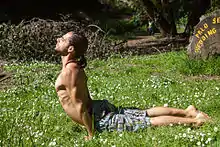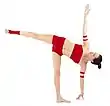Urdhva Mukha Shvanasana
Urdhva Mukha Shvanasana (Sanskrit: ऊर्ध्वमुखश्वानासन IAST: Urdhva mukha śvānāsana) or Upward Facing Dog Pose is a back-bending asana in modern yoga as exercise.[1][2] It is commonly part of the widely-performed Surya Namaskar (Salute to the Sun) sequence,[3] though the similar Bhujangasana (cobra pose) may be used there instead.[4]

Etymology and origins
The name of the pose is from the Sanskrit ऊर्ध्व Urdhva, "upwards"; मुख Mukha, "face"; and श्वान Shvana, "dog".[5] The pose is one of those (along with Downward Dog) introduced by Krishnamacharya in the mid-20th century from Surya Namaskar, not then considered to be yoga, and later taught by his pupils Pattabhi Jois and B. K. S. Iyengar.[6][7]
Description
The pose is entered with an inhalation from a prone position (or from a pose such as Chaturanga Dandasana or Ashtanga Namaskara in a Surya Namaskar cycle), taking the feet a little apart. The legs are stretched out straight, the toes out (not tucked under), and the weight of the body is supported on the hands with outstretched arms so the hips are off the ground. The gaze is directed straight upwards, so the neck and back are arched.[5]
Claims
Twentieth century advocates of some schools of yoga, such as B. K. S. Iyengar, made claims for the effects of yoga on specific organs, without adducing any evidence.[8][9] Iyengar claimed that this pose "rejuvenates the spine",[10] recommending it for stiff backs, lumbago, sciatica and slipped discs. He claimed that it strengthened the spine and gave "elasticity"[10] to the lungs, and that it made the blood circulate "properly in the pelvic region",[10] keeping it healthy.[10]
References
- "Urdhva Mukha Shvanasana". AshtangaYoga.info. Retrieved 2011-04-11.
- "Upward-Facing Dog | Yoga Poses". Yoga Journal. Retrieved 2013-08-02.
- Russo, Tiffany (11 January 2016). "Back to Basics: Upward-Facing Dog Breakdown". Yoga Journal. Retrieved 21 November 2018.
- "Bhujangasana (Cobra Pose) Steps and Benefits Video". 20 September 2017. Retrieved 21 November 2018.
- Mehta 1990, p. 91.
- Singleton 2010, pp. 204-205.
- Singleton, Mark (4 February 2011). "The Ancient & Modern Roots of Yoga". Yoga Journal.
- Newcombe 2019, pp. 203-227, Chapter "Yoga as Therapy".
- Jain 2015, pp. 82–83.
- Iyengar 1979, p. 109.
Sources
- Iyengar, B. K. S. (1979) [1966]. Light on Yoga: Yoga Dipika. Unwin Paperbacks. ISBN 978-1855381667.
- Jain, Andrea (2015). Selling Yoga : from Counterculture to Pop culture. Oxford University Press. ISBN 978-0-19-939024-3. OCLC 878953765.
- Mehta, Silva; Mehta, Mira; Mehta, Shyam (1990). Yoga: The Iyengar Way. Dorling Kindersley.
- Newcombe, Suzanne (2019). Yoga in Britain: Stretching Spirituality and Educating Yogis. Bristol, England: Equinox Publishing. ISBN 978-1-78179-661-0.
- Singleton, Mark (2010). Yoga Body : the origins of modern posture practice. Oxford University Press. ISBN 978-0-19-539534-1. OCLC 318191988.
_from_Jogapradipika_1830_(detail).jpg.webp)
